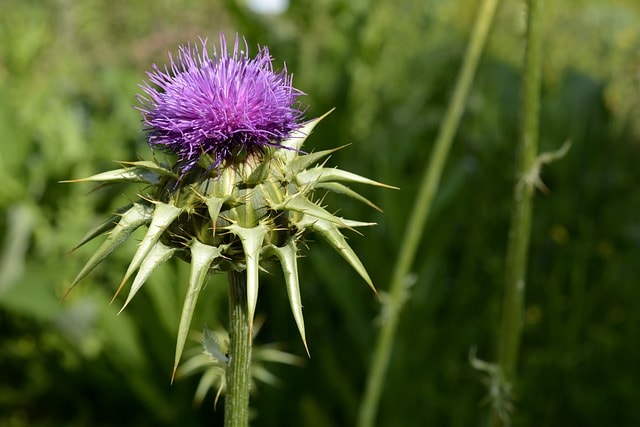Milk Thistle for Horses: A Natural Remedy
Do you care about your horse's health and want to support its natural vitality? Then milk thistle is an excellent choice! This ancient remedy, whose name goes back to Saint Mary, offers many benefits for your horse's liver and metabolism.
In this detailed article you will learn everything about the effects, applications and possibilities of this special herb.
What is milk thistle?
Milk thistle, also known by its botanical name Silybum marianum, is a plant in the daisy family native to southern Europe and the Mediterranean. It is often called liverwort because it has been known since ancient times for its regenerating and protective properties.
The main active ingredient in milk thistle, silymarin, is found primarily in the seeds. This ingredient has a unique ability: it protects liver cells, promotes their regeneration and supports liver function. But not only the seeds, but also the milk thistle herb and the milk thistle oil obtained from it are valuable aids in horse feeding.

Why is milk thistle so important for horses?
The liver is one of the central organs in your horse - it carries out vital tasks such as detoxification, regulating metabolism and producing digestive enzymes. A healthy liver also plays a key role in the immune system and ensures a shiny coat and a smooth coat change. But it can quickly become overloaded, for example due to:
-
poor feed quality,
-
Medicines such as dewormers,
-
environmental toxins,
-
Stress or metabolic problems.
Milk thistle for horses offers natural support here. The plant substances in milk thistle help to relieve the liver and improve its function.
The main benefits of milk thistle
Milk thistle has a variety of effects:
-
Protection of liver cells: The ingredient silymarin protects liver cells from damage caused by toxins.
-
Regeneration: Silymarin promotes the renewal of damaged liver cells and supports regeneration.
-
Detoxification: Milk thistle helps relieve the liver of the burden of processing toxins.
-
Support of metabolism: A healthy liver improves your horse’s overall metabolism.
-
Shiny coat and easy shedding: The liver is of central importance for the skin and coat health of your horse.
-
Antioxidant effect: The plant substances contained neutralize free radicals that attack cells.
Milk thistle is therefore not only a herb for horses with acute liver problems, but also a valuable companion for prevention and general health promotion.
In which cases does the use of milk thistle make sense?
Milk thistle and milk thistle products are particularly suitable for horses with:
-
liver problems or metabolic disorders,
-
Laminitis, EMS or Cushing,
-
a weak immune system,
-
Exposure to medication or environmental toxins,
-
older horses that need support with liver function,
-
Skin or coat problems, which are often related to an overloaded liver.
Even after a worming treatment or medication, milk thistle can help stimulate the liver's detoxification processes.
How is milk thistle used in horse feeding?
There are various products available for feeding horses.
Milk thistle seeds: The seeds contain the highest proportion of silymarin and are ideal for supporting the liver. They can be added to the feed whole or ground. Ground seeds are better utilized by the horse.
Milk thistle oil: This oil is a good source of omega-6 fatty acids and helps strengthen the liver and immune system. It can easily be added to the food.
Milk thistle herb: The herb is an additional option, especially in combination with other herbs such as dandelion or nettle, which can enhance the effect.
Finished products: Many manufacturers offer pellets or powders that are specially developed for horses and make it easier to dose correctly.
Dosage and Application
The correct dosage depends on the weight and size of your horse. As a general rule of thumb:
-
30 to 50 grams of milk thistle seeds per day for a large horse,
-
smaller quantities for ponies or easy-feeding horses.
It is best to feed milk thistle as a course over a period of six to eight weeks. This gives the liver enough time to regenerate. You can also add milk thistle oil to the food every day, but in smaller quantities.
If in doubt, always speak to your veterinarian to determine the optimal dosage for your horse.
Are there any side effects?
Milk thistle is considered to be well tolerated and generally has no side effects. Nevertheless, you should introduce it slowly to test tolerance.
Conclusion: Milk thistle – a valuable helper for your horse
Milk thistle is more than just a herb - it is a real all-rounder for your horse's health. Whether as support for liver problems, to improve metabolism or for a shiny coat: this old remedy from southern Europe has earned its place in horse feeding.
With its antioxidant effect, valuable ingredients such as silymarin and vitamin E as well as its ability to regenerate liver cells, milk thistle offers everything your horse needs for a healthy liver.
















